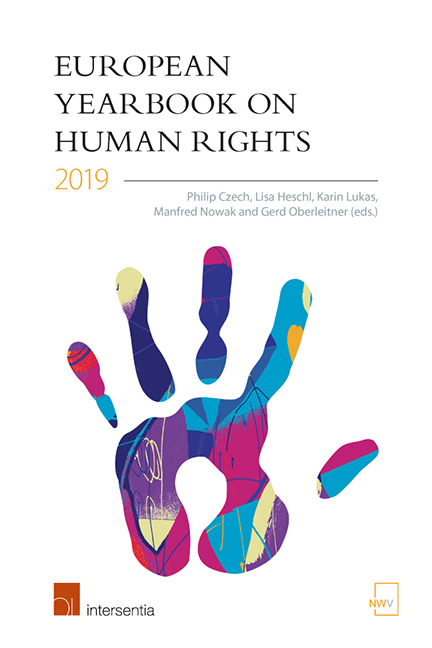Book contents
- Frontmatter
- Miscellaneous Frontmatter
- Editors’ Preface
- Contents
- List of Abbreviations
- List of Contributors
- PART I TOPIC OF THE YEAR
- PART II EU
- PART III CoE
- PART IV OSCE
- PART V REPORTS FROM THE FIELD
- PART VI OTHERS
- PART VII BOOK REVIEWS
- Lisa Heschl: Protecting the Rights of Refugees Beyond European Borders – Establishing Extraterritorial Legal Responsibilities
- Lorenza Violini and Antonia Baraggia (eds.): The Fragmented Landscape of Fundamental Rights Protection in Europe
- Panos Kapotas and Vassilis P. Tzevelekos (eds.): Building Consensus on European Consensus – Judicial Interpretation of Human Rights in Europe and Beyond
- Pieter van Dijk, Fried van Hoof, Arjen van Rijn and Leo Zwaak (eds.): Theory and Practice of the European Convention on Human Rights
- Adrienne Yong: The Rise and Decline of Fundamental Rights in EU Citizenship
- Jeroen Temperman, T. Jeremy Gunn and Malcolm Evans (eds.): The European Court of Human Rights and the Freedom of Religion or Belief – The 25 years since Kokkinakis
- Janneke Gerards: General Principles of the European Convention on Human Rights
- Index
Pieter van Dijk, Fried van Hoof, Arjen van Rijn and Leo Zwaak (eds.): Theory and Practice of the European Convention on Human Rights
from PART VII - BOOK REVIEWS
Published online by Cambridge University Press: 24 January 2020
- Frontmatter
- Miscellaneous Frontmatter
- Editors’ Preface
- Contents
- List of Abbreviations
- List of Contributors
- PART I TOPIC OF THE YEAR
- PART II EU
- PART III CoE
- PART IV OSCE
- PART V REPORTS FROM THE FIELD
- PART VI OTHERS
- PART VII BOOK REVIEWS
- Lisa Heschl: Protecting the Rights of Refugees Beyond European Borders – Establishing Extraterritorial Legal Responsibilities
- Lorenza Violini and Antonia Baraggia (eds.): The Fragmented Landscape of Fundamental Rights Protection in Europe
- Panos Kapotas and Vassilis P. Tzevelekos (eds.): Building Consensus on European Consensus – Judicial Interpretation of Human Rights in Europe and Beyond
- Pieter van Dijk, Fried van Hoof, Arjen van Rijn and Leo Zwaak (eds.): Theory and Practice of the European Convention on Human Rights
- Adrienne Yong: The Rise and Decline of Fundamental Rights in EU Citizenship
- Jeroen Temperman, T. Jeremy Gunn and Malcolm Evans (eds.): The European Court of Human Rights and the Freedom of Religion or Belief – The 25 years since Kokkinakis
- Janneke Gerards: General Principles of the European Convention on Human Rights
- Index
Summary
Theory and Practice of the European Convention on Human Rights provides an overview of the case law decided by the European Court of Human Rights (ECtHR) with regard to the rights under the European Convention on Human Rights and Fundamental Freedoms (ECHR) and its Protocols. The history of this well-established handbook goes back to 1979. Unfortunately, the co-editors Pieter van Dijk and Fried van Hoof were no longer able to participate in this most recent edition. As the title suggests, the authors, primarily Dutch and Belgian scholars of law, distinguish themselves through a balanced mix of practical and theoretical backgrounds. The editors’ focus is not on the Benelux context; instead they reach out to an international audience.
More than ten years have gone by since the previous edition in 2006, and the entry into force of Protocol No. 14 made a new edition necessary. This fifthedition includes current case law, for example Al-Skeini and Others v The United Kingdom, which declared states responsible for extraterritorial violations of human rights. As the sheer amount of case law is enormous and ever-growing, the editors decided to incorporate the new case law into individual articles and update specific articles online. Therefore, the book now comprises 37 chapters.
The first chapter provides a general survey of the Convention while the second chapter elaborates on the procedure before the court. The following chapters deal with the supervisory task of the Committee of Ministers and the supervisory function of the Secretary-General, the restrictions of rights guaranteed by the ECHR and the relationship between the ECHR and the European Union. The remaining chapters 6 to 37 are each dedicated to a specific fundamental right.
Given that procedural issues have a huge impact on the protection of human rights before the ECtHR, the book dedicates 192 pages to this chapter. Of the 42,761 applications submitted in 2018, 40,023 were declared inadmissible or struck out by single-judge decisions and only 2,738 cases were decided by judgment. These statistics show the importance of the procedure before the ECtHR.
When the Treaty of Lisbon entered into force in 2009, the EU received a binding catalogue of fundamental rights, i.e. the EU Charter of Fundamental Rights (CFR). This gave rise to a coexistence of two supranational systems protecting fundamental rights.
- Type
- Chapter
- Information
- European Yearbook on Human Rights 2019 , pp. 575 - 576Publisher: IntersentiaPrint publication year: 2019
- 2
- Cited by



